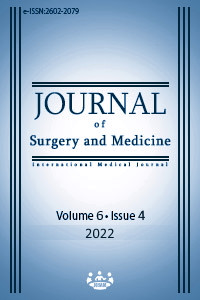Public awareness of first aid treatment in acute burns
Keywords:
Awareness of first aid treatment, Acute burn, Malaysia population, Running tap waterAbstract
Background/Aim: Burn injury is a global public health concern. First aid in burns can reduce morbidity and mortality by stopping the burning process and reducing the size and ultimate depth of the burn injury. The aim of this study is to assess the knowledge about first aid for burns in an urban population in Malaysia. Methods: We conducted a cross-sectional study using questionnaires to assess the knowledge about first aid for acute burns in our single tertiary main national referral unit for burn injuries. A total of 100 respondents were interviewed. Respondents were voluntary outpatients in the surgical outpatient department. Results: Twenty-two percent of the respondents complied with World Health Organization (WHO) recommendations. Other methods used were toothpaste (5.6%), soy sauce (4.4%), traditional oils (3.3%), aloe vera gels (2.2%), and a variety of creams (3.3%). Twenty-five percent agreed that the best information in first aid is through a first aid course; 15% chose a phone application, 14% chose a website, and 12% chose a television advertisement. The recommended first aid treatment (running tap water for ≥ 20 minutes) has proven beneficial in reducing tissue temperature and severity of injury. Conclusion: In 2019, 91% of the Malaysia population had access to the internet, which offers fast and reliable information on first aid for acute burn injuries. The majority of our population still lacks knowledge about first aid treatment for acute burns. Implementation of education regarding burn first aid should target all populations in Malaysia through different community health campaigns, with collaboration between government and non-governmental agencies.
Downloads
References
Dr Etienne Krug. Burns. World Health Organization; 2018. http://www.who.int/news-room/fact-sheets/detail/burns. Accessed 23 September 2020.
Somasundaram S, Nasir-Zahari M. A review of burns patients admitted to the Burns Unit of Hospital Universiti Kebangsaan Malaysia. Med J Malaysia. 2002;57:418–25.
Sul NS, Ahmad SH, Wan Azman WS, Arman ZMS, Siti Fatimah NMJ. The Practice of First Aid for Burn Injuries Among the Population of East Coast of Peninsular Malaysia for 2012–2016. Journal of Burn Care and Research. 2020 Jul 3;41(4):905-907.
Bartlett N, Yuan J, Holland AJ, Harvey JG, Martin HC, La Hei ER, et al. Optimal duration of cooling for an acute scald contact burn injury in a porcine model. J Burn Care Res, 2008; 29:828-34.
Leila C, John P, James RM, Roy MK. A Review of First Aid Treatments for burn injuries. Burns: journal of the International Society for Burn Injuries. April 2009;35(6):768-75.
Cuttle L, Kravchuk O, Wallis B, Kimble RM. An audit of first-aid treatment of pediatric burns patients and their clinical outcome. J Burn Care Res. 2009;30:1028–34.
Harvey LA, Barr ML, Poulos RG, Finch CF, Sherker S, Harvey JG. A population-based survey of knowledge of first aid for burns in New South Wales. Med J Aust. 2011; 195:465–8.
M Davies, S Maguire, C Okolie, W Watkins, A M Kemp. How much do parents know about first aid for burns? Burns. 2013 Sep;39(6):1083-90.
Davies JW. Prompt cooling of burned areas: a review of benefits and the effector mechanisms. Burns Incl Therm Inj. 1982;9:1–6.
Cuttle L, Kempf M, Kravchuk O, Philips GE, Mill J, Wang XQ, et al. The optimal temperature of first aid treatment for partial thickness burn injuries. Wound Repair Regen. 2008;16:626–34.
Tobalem M, Harder Y, Tschanz E, Speidel V, Pittet-Cuenod B, Wettstein R. First-aid with warm water delays burn progression and increases skin survival. JPRAS. 2013;66:260–6
Jandera V, Hudson DA, de Wet PM, Innes PM, Rode H . Cooling the burn wound: evaluation of different modalities. Burns. 2000; 26: 265–70
Cuttle L, Kimber RM. First aid treatment of burn injuries. Wound Practice and Research, 2010;18:6-13
Adam J, Janet G, Henry CT, Kerry AC. Peadiatric First Aid Knowledge Among Parents. Pediatric emergency care. 2005;20(12):808-11.
Kattan Abdullah E, Alsomer F, Abdulaziz KA, Abdullah A, Albara A. Current knowledge of burn injury first aid practices and applied traditional remedies: a nationwide survey. Burns & trauma. 2 Nov 2016;4(37)
Scheven D, Barker P, Govindasamy J. Burns in rural Kwa-Zulu Natal: epidemiology and the need for community health education. Burns. 2012;38(8):1224–30.
Statista Research Department. Internet user penetration Malaysia 2015-2025. 28 July 2020. https://www.statista.com/statistics/975058/internetpenetration-rate-in-malaysia/. Assessed 20 Sept 2020.
Lemeshow S, Hosmer DW, Klar J, Lwanga SK, Organization WH. Adequacy of sample size in health studies. 1990.
Downloads
- 819 639
Published
Issue
Section
How to Cite
License
Copyright (c) 2022 Ho Kit Lum, U-Nee Lam, Hidayah Hn, Trevor A Fernandez, Dhanya Kuladeva, Nur Shazwani Farah, Shah Jumaat Mohd Yussof, Salina Ibrahim
This work is licensed under a Creative Commons Attribution-NonCommercial-NoDerivatives 4.0 International License.
















